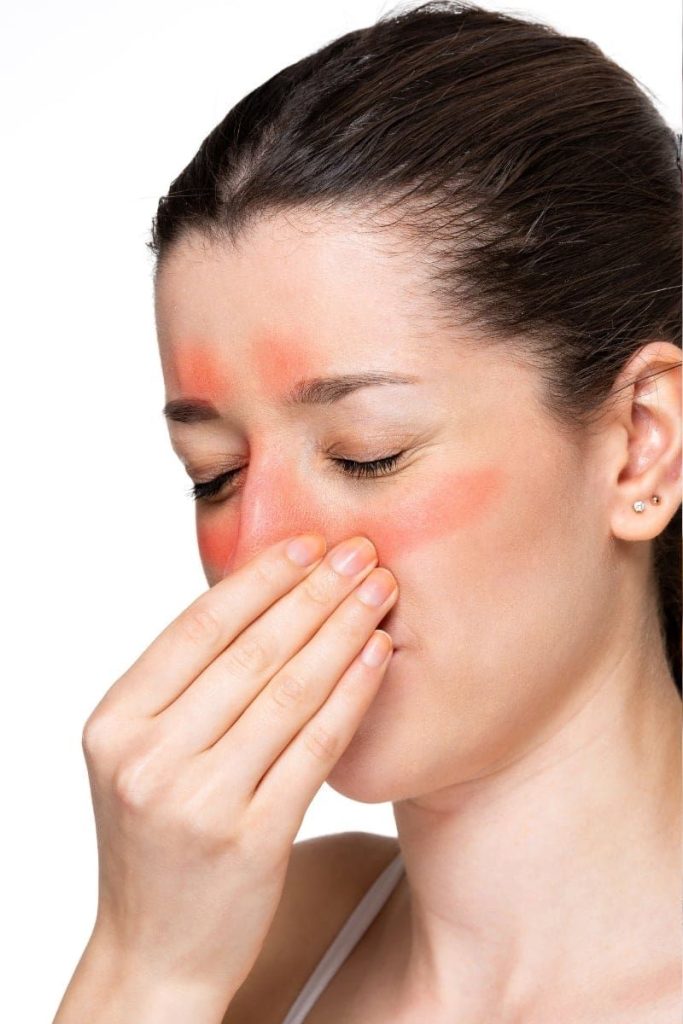
Sinusitis, known as Dushta Pratishyaya or Peenasa in Ayurveda, is primarily considered an imbalance of Kapha and Vata Doshas, leading to the accumulation of sticky mucus (Shleshma) and blockage of the sinus passages (Pranavaha Srotas). Pitta Dosha can also be involved, especially in cases with inflammation, redness, or yellowish discharge. The underlying factors include weak digestive fire (Mandagni), leading to Ama (toxin) formation, poor immunity, and exposure to cold, damp environments or allergens.
Ayurvedic treatment for sinusitis is holistic and aims to:
- Reduce Kapha and Vata accumulation.
- Clear blocked sinus passages.
- Eliminate Ama (toxins).
- Reduce inflammation and infection.
- Strengthen immunity and prevent recurrence.
- Improve digestion.
Here’s a detailed overview of Ayurvedic treatment approaches for sinusitis:
I. Shodhana (Panchakarma – Detoxification and Purification Therapies): Panchakarma plays a crucial role, especially for chronic or recurrent sinusitis, by deeply cleansing the body and restoring doshic balance.
- Nasya (Nasal Administration of Medicated Substances):
- Description: This is considered the most important and effective treatment for sinusitis. Medicated oils (like Anu Taila, Shadbindu Taila, Ksheerabala Taila) or herbal powders/decoctions are instilled into the nostrils.
- Benefits: Directly clears accumulated mucus, lubricates nasal passages, reduces inflammation, strengthens the nasal mucosa, and helps to eliminate toxins from the head and neck region. It improves the sense of smell and clarity of mind. Often performed after gentle facial massage and steam inhalation.
- Swedana (Fomentation/Steam Therapy):
- Description: Localized steam inhalation is highly beneficial. Herbs like Eucalyptus leaves, Tulsi (Holy Basil), Ajwain (Carom seeds), Mint leaves, or a few drops of Eucalyptus oil can be added to hot water.
- Benefits: Loosens thick mucus, reduces congestion, eases breathing, and alleviates facial pressure and headache.
- Vamana (Therapeutic Emesis):
- Description: Medically induced vomiting to eliminate excess Kapha and Ama from the upper respiratory and gastrointestinal tracts.
- Benefits: Particularly useful for chronic sinusitis with heavy mucus production, congestion, and a feeling of heaviness, as Kapha is directly targeted.
- Virechana (Therapeutic Purgation):
- Description: Medically induced purgation to eliminate vitiated Pitta (if present) and Ama from the gastrointestinal tract.
- Benefits: Helps cleanse the body systemically, reduces inflammation, and improves overall metabolism, which is crucial for preventing Ama formation.
II. Bahya Chikitsa (External Therapies):
- Jala Neti (Nasal Saline Rinse):
- Description: Using a Neti pot, lukewarm saline water (distilled or boiled and cooled water with non-iodized salt) is poured through one nostril and allowed to drain out the other.
- Benefits: Effectively cleanses the nasal passages of allergens, irritants, dust, and excess mucus. Regular practice can prevent recurrence and maintain sinus health. (Should be done correctly to avoid complications).
- Dhumapana (Herbal Smoking/Fumigation):
- Description: Inhaling medicated smoke from specific herbs or herbal mixtures. Haridra Choorna (Turmeric powder) is commonly used.
- Benefits: Helps to dry up excess Kapha, clear nasal passages, and reduce congestion. (To be done under professional guidance).
- Pratimarsha Nasya (Daily Nasya):
- Description: A simpler, daily practice of applying 1-2 drops of warm sesame oil or Anu Taila to each nostril with a clean finger.
- Benefits: Keeps nasal passages moisturized, prevents dryness, and provides a protective barrier against allergens and irritants.
- Gandusha / Kavala (Oil Pulling / Gargling):
- Description: Swishing medicated oil (like sesame oil or Triphala oil) or herbal decoctions in the mouth for several minutes.
- Benefits: Helps detoxify the oral cavity, reduces Kapha accumulation in the throat, and can indirectly benefit sinus health by improving overall upper respiratory hygiene.
- Local Application: Applying warm pastes of ginger and turmeric on the forehead can help relieve sinus pressure and pain.
III. Shamana (Palliative Therapies & Herbal Medicines): These involve internal medications to reduce symptoms, clear blockages, and boost immunity.
- Herbs to Reduce Kapha & Ama:
- Trikatu (Ginger, Black Pepper, Long Pepper): A powerful blend to kindle Agni, burn Ama, and reduce Kapha and mucus.
- Ginger (Adraka): Anti-inflammatory, decongestant, and helps thin mucus.
- Turmeric (Haridra): Potent anti-inflammatory, antiseptic, and immune-modulating. Often used with warm milk (Golden Milk) or honey.
- Tulsi (Holy Basil): Anti-allergic, anti-inflammatory, and improves respiratory function.
- Vasa (Adhatoda vasica): Expectorant, helps clear bronchial and sinus congestion.
- Licorice (Yashtimadhu): Soothes irritated mucous membranes, anti-inflammatory.
- Kantakari (Solanum xanthocarpum): Expectorant, useful for respiratory congestion.
- Nirgundi (Vitex negundo): Anti-inflammatory, analgesic, useful for sinus headaches.
- Classical Formulations:
- Sitopaladi Churna: Helps reduce congestion, cough, and improve respiratory health.
- Talisadi Churna: Aromatic, helps clear congestion and improves digestion.
- Laxmivilas Ras, Tribhuvan Kirti Ras, Shringarabhra Rasa: Used for acute symptoms, fever, and inflammation (to be taken under strict medical supervision).
- Triphala: Gentle detoxifier, helps in regular bowel movements to prevent Ama.
- Chyawanprash: Immunomodulator, strengthens respiratory system, helps prevent recurrent infections.
- Haridra Khandam: Often used for allergic rhinitis and skin allergies, which can be linked to chronic sinusitis.